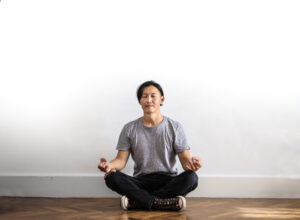Guest blog post by Derek Moore, CADC
Why should you try mindfulness exercises for anxiety? Because mindfulness teaches you to battle stress with awareness by becoming aware of what is happening right now, instead of being a victim to instinct or driven by emotion. Keep reading to learn how to get started.
Not sure what mindfulness is? Start here to learn more.
Why Am I Experiencing Anxiety?
 When you’re in the thick of it, anxiety feels pretty uncomfortable. However, anxiety does serve a purpose. Anxiety is supposed to warn you that your body is perceiving some danger, physical or psychological, that might cause you harm. Your system is being prepared to manage that threat.
When you’re in the thick of it, anxiety feels pretty uncomfortable. However, anxiety does serve a purpose. Anxiety is supposed to warn you that your body is perceiving some danger, physical or psychological, that might cause you harm. Your system is being prepared to manage that threat.
So you can consciously look at your anxiety as something that keeps you safe. The sweaty palms, racing heart, and uncomfortable gut feeling is your body’s natural alarm system telling you, “Hey, something is wrong here.”
Anxiety is beneficial when it is a short passing emotion. It acts as a protective mechanism for your body and brain. However, anxiety becomes unmanageable when you become stuck in it. You might even unknowingly be reinforcing the perpetuation of anxiety symptoms by trying to avoid the “threat.”
Is your first response to find the fastest way to rid of that feeling? Perhaps avoid the scary situation or soothe or numb yourself with food or alcohol? Unfortunately, when you don’t actually address the emotions and sensations in your body by giving into that initial avoidance urge, you only reinforce the anxiety.
That is when mindfulness comes into play.
Related Reading: How You Can Manage Fear and Anxiety Today
Mindfulness for Anxiety Relief
 Merriam-Webster’s dictionary defines mindfulness as the practice of maintaining a nonjudgmental state of heightened or complete awareness of one’s thoughts, emotions, or experiences on a moment-to-moment basis. Increasing mindfulness by bringing intentional awareness to the moment can have a huge effect in relieving anxiety.
Merriam-Webster’s dictionary defines mindfulness as the practice of maintaining a nonjudgmental state of heightened or complete awareness of one’s thoughts, emotions, or experiences on a moment-to-moment basis. Increasing mindfulness by bringing intentional awareness to the moment can have a huge effect in relieving anxiety.
Evidenced-based practices like Dialectical Behavioral Therapy, Cognitive Behavioral Therapy, and Acceptance and Commitment Therapy are a few examples that have incorporated mindfulness into their framework. Here are a couple of common mindfulness techniques that therapists utilize to combat anxiety and depression in their clients (and themselves!).
Worth While Mindfulness Exercises for Anxiety:
Anxiety Breathing Exercises
- Four Square Breathing – imagine a square (actually visualize this). Trace the first side of the square with 4 seconds of breathing in. Then, as you transition to the second side’s tracing, expel your breath over 4 seconds. Complete these two steps again to complete the four sides of the square. After you have filled that square with breaths, visualize yourself pushing that square out of view and begin filling up another box until anxiety symptoms begin to pass.
- Color Breathing– Start by finding a comfortable position and close your eyes. Allow yourself to breathe naturally. As you begin to relax into your natural breathing pattern, begin to focus on your breath. Slowly start to visualize the air you inhale as the color you associate with words like calming or soothing. As you inhale that color, imagine the color is coursing through your body, filling you with its calm. As you exhale, visualize that air with a color you associate with stress or negative energy, allowing the tension to leave your body. Complete this exercise as many times as you feel needed, but don’t forget to check in with yourself after you finish the exercise. Consider the following questions: Why did I choose those colors? What did those colors mean to me? Become aware of the associations you made.
Progressive Muscle Relaxation Techniques (PMR)
 The most common way to use this technique is sitting in a comfortable chair or simply laying in a position that you are comfortable in. You can start this technique by using an internal dialogue. As you begin to focus on your face, invite the muscles there to gently scrunch, tensing the facial muscles for 5-10 seconds, then slowly release them. Slowly move on to the muscles in your neck, again gently tightening those muscles or rolling your neck for 5-10 seconds. When you feel ready, move on from your neck to your core, then your upper legs, followed by your lower legs, then your feet. In each place, invite the muscles to tense for 5-10 seconds. After your feet, come up to the shoulders, then move on to the upper arms (biceps and triceps), then to your forearms, and then finishing with your hands and fingers. Remember, you are just gently tensing or flexing for about 5-10 seconds before slowly releasing.
The most common way to use this technique is sitting in a comfortable chair or simply laying in a position that you are comfortable in. You can start this technique by using an internal dialogue. As you begin to focus on your face, invite the muscles there to gently scrunch, tensing the facial muscles for 5-10 seconds, then slowly release them. Slowly move on to the muscles in your neck, again gently tightening those muscles or rolling your neck for 5-10 seconds. When you feel ready, move on from your neck to your core, then your upper legs, followed by your lower legs, then your feet. In each place, invite the muscles to tense for 5-10 seconds. After your feet, come up to the shoulders, then move on to the upper arms (biceps and triceps), then to your forearms, and then finishing with your hands and fingers. Remember, you are just gently tensing or flexing for about 5-10 seconds before slowly releasing.- A second option that many therapists take is directing you towards the loads of free resources available online. You can simply search “PMR” or “progressive muscle relaxations” in your search engine, and find results with many videos ranging from 1 minute to 1 hour that will guide you through this mindfulness coping skill for anxiety and depression. Here are a few videos to get you started on this journey below.
- Progressive Muscle Relaxation One (Runtime: 14:55)
- Progressive Muscle Relaxation Two (Runtime: 5:03)
- Progressive Muscle Relaxation Three (Runtime: 1:00:04)
Related Reading: 5 Mindfulness Exercise for Your Anxious Teen
Need Anxiety Help?
 Therapists turn to mindfulness as a coping skill for depression and anxiety because many research backs it. It’s been found that “individuals will become less reactive to unpleasant internal phenomena but more reflective, which in turn will lead to positive psychological outcomes.” Mindfulness is a skill that therapists can teach clients in session, but you can use it outside of the session once learned.
Therapists turn to mindfulness as a coping skill for depression and anxiety because many research backs it. It’s been found that “individuals will become less reactive to unpleasant internal phenomena but more reflective, which in turn will lead to positive psychological outcomes.” Mindfulness is a skill that therapists can teach clients in session, but you can use it outside of the session once learned.
With daily use of mindfulness as a coping skill, you will have better self-control in overwhelming experiences outside your therapy session. This emotional regulation can create more solution-focused treatment and help your therapy sessions become more productive.
If you want to learn more mindfulness exercises for anxiety, schedule with an anxiety therapist at Life Care Wellness at any of our three Chicago, Illinois area locations (Glen Ellyn, Jefferson Park, and Sycamore). Our qualified therapists can help guide you through the many mindfulness-based depression and anxiety coping skills to help you to feel whole and secure.





